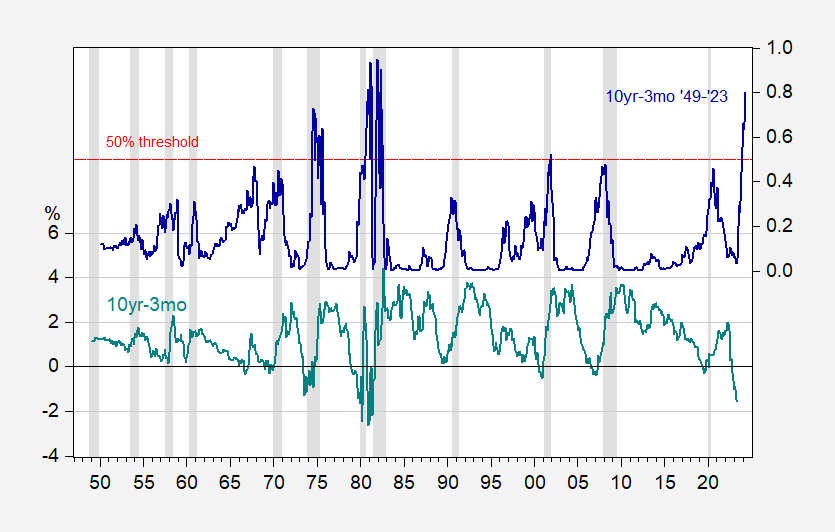If you were interested.
Figure 1: 10yr-3mo Treasury spread, % (teal, left scale), and implied probability of recession 12 months ahead (blue, right scale). NBER defined peak-to-trough recession dates shaded gray. Source: Treasury via FRED, NBER, and author’s calculations.
McFadden R2 for this regression is 0.23. Note that a 0.3 threshold would then catch every recession in the last 74 years, but also predict the recessions of 1958 and 1999…

https://news.cgtn.com/news/2023-06-12/China-s-installed-non-fossil-electricity-generation-exceeds-50-percent-1kzXyHZvOEg/index.html
June 12, 2023
China’s installed non-fossil electricity generation exceeds 50 percent of total
The installed capacity of non-fossil fuel energy power generation in China has exceeded 50 percent, an official at the country’s National Development and Reform Commission (NDRC) said on Monday.
Non-fossil fuel energy power, such as wind, solar and hydro power, accounts for 50.9 percent of China’s total installed capacity, exceeding that of fossil energy, according to Yang Yinkai, NDRC’s deputy director, at a conference held in Shanghai. The achievement comes in advance of the country’s goal to have non-fossil capacity surpass that of fossil fuel by 2025.
China aims to have its carbon dioxide emission peak before 2030 and achieve carbon neutrality in 2060.
Though the country’s energy consumption mix remains weighted toward fossil fuels, with coal accounting for 56.2 percent of total consumption last year, progress has been made in promoting green and low-carbon energy.
To accelerate energy transformation, the country has built large-scale photovoltaic and wind power bases in deserts in recent years, said Yang.
The country has also made efforts in coal-fired power units’ technical transformation for energy conservation, carbon reduction, replacement of low efficiency boilers and improving load regulation capacity, Yang added.
A structured matrix of large hydropower stations in the basins of major rivers have also been built, especially in the southwest….
Definitely interested. Thank you!
So the question about mechanisms of correlation should be analyzed in more detail. Why did the correlation break down in 1968 and in the late 1990’ies. Why did it hold up so well all the other times. Are these changes in spread an inevitable part of recessions and why. Does a recession drive the changes in spread and what is different this time that will explain why we won’t get a recession in spite of a huge “signal” from a normally reliable surrogate marker?
I keep trying to post a semi-long comment (not that long) in which I get a “500 Internal Server Error” and it’s about driving me nuts.
https://developer.mozilla.org/en-US/docs/Web/HTTP/Status/500#:~:text=The%20HyperText%20Transfer%20Protocol%20(HTTP,%22catch%2Dall%22%20response.